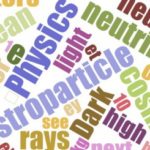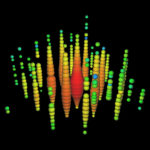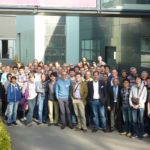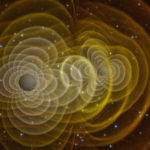
Gamma-ray burst brightest ever seen
10 November 2013

10 November 2013

10 November 2013
Space Daily – New dark matter detector sends first data from gold mine 1.5km underground

10 October 2013

26 September 2013
In one of the episodes of the “Sesame Street”, the protagonists Ernie and Bert debate on Ernie’s frozen ice cubes which miraculously had disappeared. The story makers could not have guessed that some forty years later, members of a 270M dollar endeavour called IceCube would debate on the miraculous appearance of two events, and that these events would be nicknamed “Ernie” and “Bert” by some imaginative PhD students. Moreover, it would have gone beyond the imagination of the Sesame Street people that these two events would be interpreted as a first hint to something what scientists call “high-energy extraterrestrial neutrinos”.
IceCube is a cubic kilometre neutrino telescope installed in the deep Antarctic ice at the South Pole. The detector consists of 86 strings each equipped with 60 light sensors. The sensors record the faint light emitted by relativistic charged particles – including those which have been generated in neutrino interactions. IceCube construction was started in December 2004 and completed in December 2010, but data have been taken already before completion, year by year, with the strings already installed.
The ultimate goal of IceCube is to identify individual sources of extraterrestrial energetic neutrinos. These are neutrinos which have not been generated in cosmic-ray collisions in the Earth’s atmosphere (IceCube has recorded more than 105 of such “atmospheric neutrinos”), but which have reached us directly from distant cosmic objects like supernova remnants or active galactic nuclei. A neutrino signal would provide a watertight proof that the corresponding object is also a source of charged cosmic rays. Although IceCube has improved the sensitivity to energetic neutrinos by a factor 1000 over the last twelve years, it could not yet pinpoint any individual source. Neutrinos from such “point-like” sources would appear as an accumulation of events from a certain direction of the sky. Instead, the IceCube scientists collected growing evidence, that there is a tiny excess of events at the very highest energies which seem to arrive as a diffuse flux from many sources, or even from all directions.
High-energy tails in the energy spectrum had been observed repeatedly in analyses of data taken with the 40-string and 59-string configurations of IceCube. These deviations exceeded the predicted spectrum for atmospheric neutrinos by roughly two standard deviations (~2s). The first step clearly beyond 2s was made with an analysis of data taken in 2010 and 2011 with the 79-string and 86-string configurations. This analysis focused to energies larger than ~500 TeV and provided two events with reconstructed energies of 1.04 and 1.14 PeV (1 PeV = 103 TeV = 106 GeV): “Ernie” and “Bert” (see the figure). Ernie and Bert represent a 2.8s excess over the expectation for atmospheric neutrinos 1.
Motivated by this result, an alternative analysis of the same data was performed. It constrains the event to start in the inner volume of IceCube (using the outer part as veto layer), and at the same time considerably lowers the threshold compared to the first analysis (down to some tens of TeV).
Results of this analysis have been firstly presented at May 14, 2013 at a conference in Madison/USA. It provides 28 events with energies deposited in the detector ranging from ~30 TeV to 1.14 PeV. “Ernie” and “Bert” stoically defend their top position in energy. Notably also the events at somewhat lower energies (~30 TeV – ~250 TeV) can hardly be explained alone by atmospheric neutrinos or by muons sneaking unrecognized from above into the detector. The calculated contribution of such “trivial” sources to the total of 28 events is estimated to only 12 events 2.
Does that mean that extraterrestrial high-energy neutrinos have incontrovertibly been detected? Certainly not! With a statistical significance of 4.1s, the excess has not yet reached the magical benchmark of 5s. Moreover one cannot exclude that estimates of the background from atmospheric neutrinos are still somewhat too low. This particularly applies to the so-called prompt neutrinos which emerge from the decay of short-lived charm particles high in the atmosphere. Such an underestimate would lead to an overestimation of the extraterrestrial contribution. However, the IceCube collaboration will have analyzed about twice the amount of data in autumn. The doubling of the statistics will go hand in hand with steadily improving understanding of systematic effects.
Summing up: we see light at the end of the tunnel – 40 years after the first detector of this kind was conceived3)! We are reluctant to open the bottles right now, but the Champagne is already in the fridge. With some luck we may pass the 5s benchmark within a few months…
1) M. Aartsen et al. (IceCube Coll.), First observation of PeV-energy neutrinos with IceCube, accepted for publication in PRL, arXiv:1304.5356
2) M. Aartsen et al. (IceCube Coll.), Evidence for High-Energy Extraterrestrial Neutrinos at the IceCube Detector, paper submitted for publication.
3) C. Spiering: Towards High-Energy Neutrino Astronomy. A Historical Review, EPJ-H 37 (2012) 515, arXiv:1207.4952

26 September 2013
The 5th Einstein Telescope (ET) symposium has been held on 22 and 22 October, 2013 in Hanover, hosted by the Albert Einstein Institute. The ET project aims at the realization of a 3rd generation Gravitational Wave (GW) observatory, a new European Research Infrastructure that will open the era of routine precision GW astronomy and astrophysics. The Hanover event was the second general meeting of the ET project, after the completion of the conceptual design study phase, supported by the European Commission in FP7-Capacities from 2008 to 2011. The vitality of the ET project showed in a large attendance: 78 participants from Europe and Japan.
The Japanese colleagues participated within the framework of ELiTES, an FP7-IRSES project, which supports the exchange of scientists between Europe and Japan, focused on the development of technologies for the future detectors KAGRA and ET. The 5th ET symposium had two main aspects:
The ET project keeps progressing thanks to the support of some European initiatives: the ELiTES and the ET R&D frameworks contribute to the R&D developments and to the realization of the technical design of the ET research infrastructures. ET R&D is an ASPERA-2 project, supported by a set of European countries, focused on the development of technologies for ET. A new cohesion and development tool has been presented at the meeting: GraWIToN. This is a 4 years FP7-ITN (Initial Training Network) that will begin in February 2014, addressed to the training of young PhD researchers in the field of GW research, of course including ET. Furthermore the potentialities of H2020 for the development of the ET project have been discussed thoroughly.
In conclusion, the 5th ET symposium has been a rewarding opportunity where the progress of the Einstein Telescope project was witnessed and where the next years for this challenging European adventure were prepared.

23 September 2013
The European Astroparticle Physics (APP) community has been greatly successful in getting funded in the context of FP7, the previous EU Framework Programme. This EU funding has greatly contributed in the quality of scientific results obtained in the last decades. It is therefore of the utmost importance for the future of the field, that this good funding track record is continued. In this spirit, APPEC is taking a proactive role in supporting the community in their efforts to take advantage of the opportunities in Horizon2020.
Specifically, APPEC is producing a document entitled “APPEC’s guide to Horizon2020” (to be distributed in the event mentioned below), whose aim is to inform as much as possible in advance the community on the details of the funding landscape of Horizon2020. Based on the information contained in this document, the following remarks can be made:
In this proactive role, APPEC is also organising a workshop to inform the community in more detail on the Horizon2020 opportunities. The event will take place on 4 and 5 of November in DESY-Zeuthen, Berlin and its structure is outlined in the Horizon2020 programme. In the first day, short talks will be given by representatives of the funding agencies in Brussels, who will then be available to answer any questions that the participants might have. The next day the participants will be divided into interest-themed groups for parallel sessions. Finally, in the afternoon of the 5th of November, the rapporteurs of these groups will present their plans and needs to the APPEC funding agencies.
It is strongly recommended that numerous members of the community will attend this workshop, whose aim is to give the participants a clear idea on the funding landscape for Astroparticle Physicists in the next two years, but also for the funding agencies to understand what will be the plans of the different parts of the community so that they can support them in these efforts.

15 September 2013

10 July 2013

9 June 2013
Nature News – High-energy γ-ray astronomy comes back to Earth

1 June 2013
The Hindu Business Line – New telescope to shed light on dark side of universe